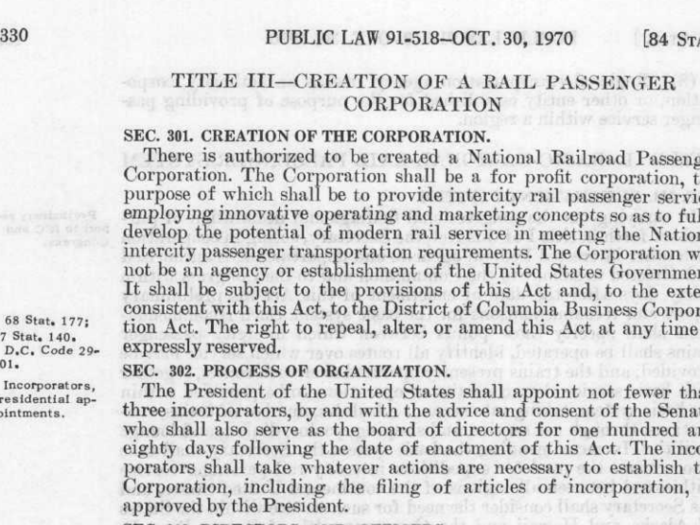
"The Congress finds that modern, efficient intercity railroad passenger service is a necessary part of a balanced transportation system," lawmakers of the 91st Congress wrote in the bill. The law established basic frameworks for the National Railroad Passenger Corporation and a 15-person board of directors.
President Nixon signed the bill into law on October 30, 1970.

Here, U.S. Secretary of Transportation John Volpe (left), Amtrak President Roger Lewis (center) and Amtrak Board of Incorporation Chairman David W. Kendall (right) unveil the original Amtrak route map.

Patty Saunders was one of the first passenger service representatives hired by Amtrak. According to Amtrak's archives, female passenger service representatives could chose from pieces such as hot pants and a floor length skirt that could be mixed with various tops and sweaters according to the season.

Here's a look at the original plan for Amtrak routes, as envisioned in the railroad's first employee newsletter (dated March 15, 1975.)


Many of the cars are still in use today, and their iconic rounded shape has become synonymous with many of Amtrak's routes.

Designed by Pullman Standard, the rail company ordered 70 sleeper cars with full bedrooms for long-haul journeys in America's heartland. The cars are 85 feet long, 10 feet wide and 16 feet high.

The Empire Builder, for instance, which runs a 2,230 mile route in 46 scheduled hours from Chicago to Seattle. Despite averaging near 500,000 annual riders, that fare revenue of just over $67 million covers only about 65% of the operating costs.

That means slow-going, and lower priority than freight trains on the same tracks. In the rest of the developed world, passenger rail is given its own right-of-way without grade crossings, allowing it to run at higher speeds and be a viable alternative to air travel or highways.

The Acela serves 14 stops in the corridor, and makes up about a quarter of Amtrak's total revenue. It first made its debut in 2000, and trainsets capable of even faster speed are set to arrive in 2021.

At the time, Amtrak was losing $347.45 per passenger on its Sunset Limited train from Florida to California. A last-minute loan agreement from the Department of Transportation provided a critical lifeline for the railroad, which ended that year with a record ridership.

Since 2010, Amtrak's revenue has consistently increased every year, as operating losses declined to $852 million. Still, there are plenty of improvements needed for the US to catch up with other modern train systems throughout the world. The century-old tunnels under the Hudson River connecting New York and New Jersey are in bad need of repair, and local officials have called on the federal government to step in for assistance. That has yet to happen.
 Average housing prices up 10% in Jan-Mar across the top eight cities
Average housing prices up 10% in Jan-Mar across the top eight cities
 Top visa-on-arrival picks for Indian explorers
Top visa-on-arrival picks for Indian explorers
 451 million voters! First four phases of Lok Sabha elections witness 66.95% voter turnout so far
451 million voters! First four phases of Lok Sabha elections witness 66.95% voter turnout so far

Copyright © 2024. Times Internet Limited. All rights reserved.For reprint rights. Times Syndication Service.